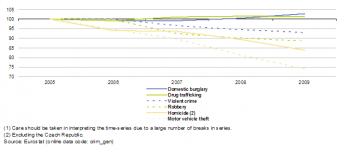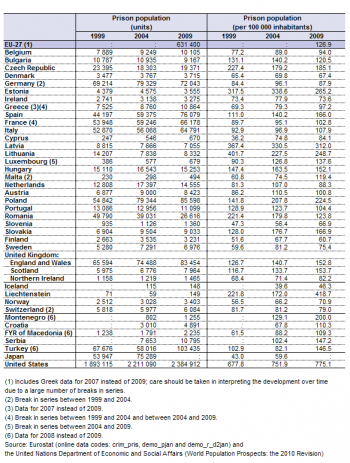Archive:Crime statistics
- Data from August 2012. Most recent data: Further Eurostat information, Main tables and Database.


(2005=100) - Source: Eurostat (crim_gen)

(per 100 000 inhabitants) - Source: Eurostat (crim_gen), (demo_pjan) and (demo_r_d2jan), and the United Nations Department of Economic and Social Affairs (World Population Prospects: the 2010 Revision)

European Union (EU) statistics currently available on crime and criminal justice reflect the diversity of policing and legal systems within the EU. Comparisons of crime statistics between Member States should focus on trends over time, rather than directly comparing levels between countries for a specific year, given that the data can be affected by a range of factors, including different levels of criminalisation, the efficiency of criminal justice systems and police recording practices; furthermore, it is likely that a relatively high proportion of crime remains unrecorded. Work is in progress to improve the comparability of crime statistics across the EU Member States.
Main statistical findings
There were 1.7 million police officers in the EU-27 in 2009, which marked an overall increase of 2.7 % when compared with four years earlier (the comparison excludes Belgium and Bulgaria) – see Table 1. There were some quite rapid changes in the size of national police forces during the period from 1999 to 2009, as the size of the police force was reduced by more than 10 % in each of the Baltic Member States and Northern Ireland; there were more modest reductions in Romania, Germany, the Czech Republic and Austria. By contrast, all of the remaining Member States recorded an increase in police numbers.
A relative measure of the size of individual police forces may be provided by analysing the number of police officers per 100 000 inhabitants. There were, on average, 338 police officers per 100 000 inhabitants in the EU-27 in 2009. Among the Member States this ratio was almost twice as high in Cyprus where there was an average of 672 police officers per 100 000 inhabitants; the next highest ratio was recorded in Spain (506). At the other end of the range, the lowest numbers of police officers per 100 000 inhabitants were recorded in Finland (156), Denmark (197) and Sweden (207).
There were an estimated 28 million crimes recorded by the police within the EU-27 in 2009 (see Table 2). From 2000, the number of recorded crimes in the EU-27 rose to a peak in 2002 and 2003, but subsequently fell each year through to 2009. Decreases of more than 10 % between 2003 and 2009 were observed in Malta, the United Kingdom, Poland, Greece and France.
Figure 1 shows the development of the number of recorded crimes in the EU-27 between 2005 and 2009 for a range of offences: the most substantial fall in the number of reported crimes over this period concerned motor vehicle theft (-26 %), while there were also significant reductions in the number of homicide and robbery offences recorded by the police. On the other hand, there was a modest increase in the number of domestic burglary (3 %) and drug trafficking (1 %) offences.
Figure 2 presents a more detailed picture of the number of homicide offences that are recorded by the police in the Member States; the data relate to an average for the period 2007-2009. Across the whole of the EU-27 there were 1.3 homicides per 100 000 inhabitants, ranging from a high of 8.3 in Lithuania – and 6.1 in neighbouring Estonia – down to less than 1 in Spain, Germany, Slovenia and Austria.
The prison population figures include all types of prison, including adult and juvenile facilities and pre-trial detainees, but exclude non-criminal prisoners held for administrative purposes such as pending investigation into their immigration status. In 2009, there were more than 630 000 prisoners in the EU-27, which equated to approximately 127 prisoners per 100 000 inhabitants. The highest rates (more than 200 prisoners per 100 000 inhabitants) were found in the Baltic Member States and Poland. At the other end of the range, the Nordic countries of Denmark, Finland and Sweden (as well as Iceland and Norway among non-member countries) each reported less than 80 prisoners per 100 000 inhabitants in 2009; elsewhere this was also the case in Slovenia and Ireland, as well as in Switzerland – see Table 3.
Data sources and availability
Eurostat publishes statistics on crime and criminal justice systems from 1950 onwards for the total number of recorded crimes, and from 1993 onwards for a set of specific offences; the database also includes statistics for prison populations from 1987 onwards and the number of police officers from 1993 onwards.
Figures for the United Kingdom are reported for the separate jurisdictions of England and Wales, Scotland, and Northern Ireland.
As a general rule, comparisons should be based upon trends rather than upon levels, on the assumption that the characteristics of the recording system within a country remain fairly constant over time. There are, however, a large number of breaks in time series and other methodological/definitional changes.
Comparisons of crime statistics between countries may be affected by a range of factors, including:
- different legal and criminal justice systems;
- the proportion of crimes reported to the police and recorded by them;
- differences in the timing of recording crimes (for example, when reported to the police, when a suspect is identified, etc.);
- differences in the rules by which multiple offences are counted;
- differences in the list of offences that are included in the overall crime figures.
Consequently, care should be taken when analysing the information presented.
Figures for the prison population may also be affected by a range of factors, including:
- the number of cases dealt with by the courts;
- the percentage of convicted criminals given a custodial sentence;
- the length of the sentences imposed; the size of the population on remand;
- the date at which the survey was conducted (especially where amnesties or other early release arrangements might apply).
The prison population should be measured as the total number of adult and juvenile prisoners (including pre-trial detainees) as of 1 September each year. The figures include offenders held in prison administration facilities, juvenile offenders' institutions, drug addicts' institutions and psychiatric or other hospitals.
The first steps towards a more comparable system of crime and criminal justice statistics were outlined in a European Commission Communication titled 'Developing a comprehensive and coherent EU strategy to measure crime and criminal justice: an EU action plan 2006-2010' (COM(2006) 437 final). In the short term, its objective was to collect national data and to assess its quality. However, the longer-term goal for the European Commission’s Directorate-General for Home Affairs is to develop, in close collaboration with Eurostat, a harmonised methodology on which the collection of EU-wide statistics should be based, allowing comparisons of the structure and trends of crime between Member States. This work continues under the 2009 Stockholm Programme 'An open and secure Europe serving and protecting citizens'.
Context
The progressive elimination of border controls within the EU has considerably facilitated the free movement of European citizens, but may have also made it easier for criminals to operate, especially since the scope of law enforcement authorities and criminal justice systems is generally limited to the boundaries of national borders.
Since the adoption of the Amsterdam Treaty, the EU has set itself the objective of providing a common area of freedom, security and justice. This goal was further developed by the Hague programme in 2004, which outlined ten priority areas: strengthening fundamental rights and citizenship; anti-terrorist measures; defining a balanced approach to migration; developing integrated management of the EU’s external borders; setting up a common asylum procedure; maximising the positive impact of immigration; striking the right balance between privacy and security while sharing information; developing a strategic concept on tackling organised crime; ensuring a genuine European area of justice; and sharing responsibility and solidarity.
As part of the work to harmonise and develop statistics on crime and criminal justice systems, EU Member States agreed to approximate the definitions of offences and the level of sanctions for certain type of offences. Furthermore, mutual recognition of decisions taken by national judges is set to become the cornerstone of judicial cooperation in criminal matters, with a range of tools having been developed to facilitate practical cooperation across borders.
With respect to police cooperation, the EU seeks to grant law enforcement authorities in each of the Member States access to relevant information (such as DNA, fingerprint, vehicle registration or immigration databases), and to improve police cooperation within a common framework for the protection of personal data. Access to information is covered by a raft of legislation, including the Data Retention Directive 2006/24/EC, the Swedish Initiative Framework Decision 2006/960/JHA, the Prüm Council Decision 2008/615/JHA and Regulation 767/2008 concerning a visa information system (VIS) and the exchange of data between Member States.
Police cooperation has been encouraged through legislation such as Framework Decision 2002/465/JHA on Joint Investigation Teams and Council Decision 2008/617/JHA on improved cooperation between special intervention units, while a range of organisations/bodies have been created to aid cooperation between different law enforcement agencies, such as the European Police College (CEPOL), the European Police Office (Europol) or the European agency for the management of operational cooperation at the external borders of the Member States of the EU (Frontex). Furthermore, the EU supports a range of national and multi-national projects, through programmes such as the ‘Prevention of and fight against crime’ (Council Decision 2007/125/JHA).
Further Eurostat information
Publications
Database
- Crimes recorded by the police (crim_gen)
- Crimes recorded by the police: homicide in cities (crim_hom_city)
- Crimes recorded by the police: historical data (total crime) 1950-2000 (crim_hist)
- Police officers (crim_plce)
- Prison population (crim_pris)
- Prison population: historical data 1987-2000 (crim_pris_hist)
Dedicated section
Methodology/Metadata
- Crime and criminal justice (ESMS metadata file - crim_esms)
Source data for tables and figures (MS Excel)
Other information
- Commission Communication COM/2006/437 final: Developing a comprehensive and coherent EU strategy to measure crime and criminal justice : an EU Action Plan 2006-2010
- The Hague Programme: strengthening freedom, security and justice in the European Union (Official Journal C 53 of 3.3.2005, p.11)
- The Stockholm Programme: An open and secure Europe serving and protecting citizens (Official Journal C 115 of 4.5.2010, p.1)
External links
- Council of Europe
- European Sourcebook of Crime and Criminal Justice Statistics
- Europol - European Police Office
- Fundamental Rights Agency
- United Nations Office on Drugs and Crime - Data and analysis
